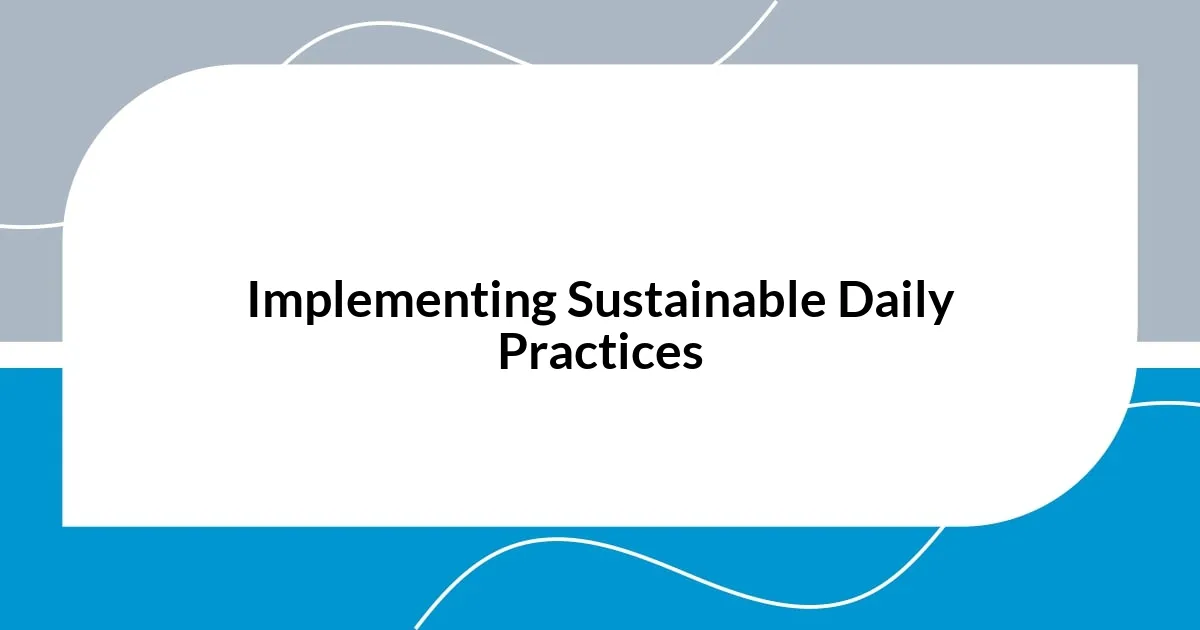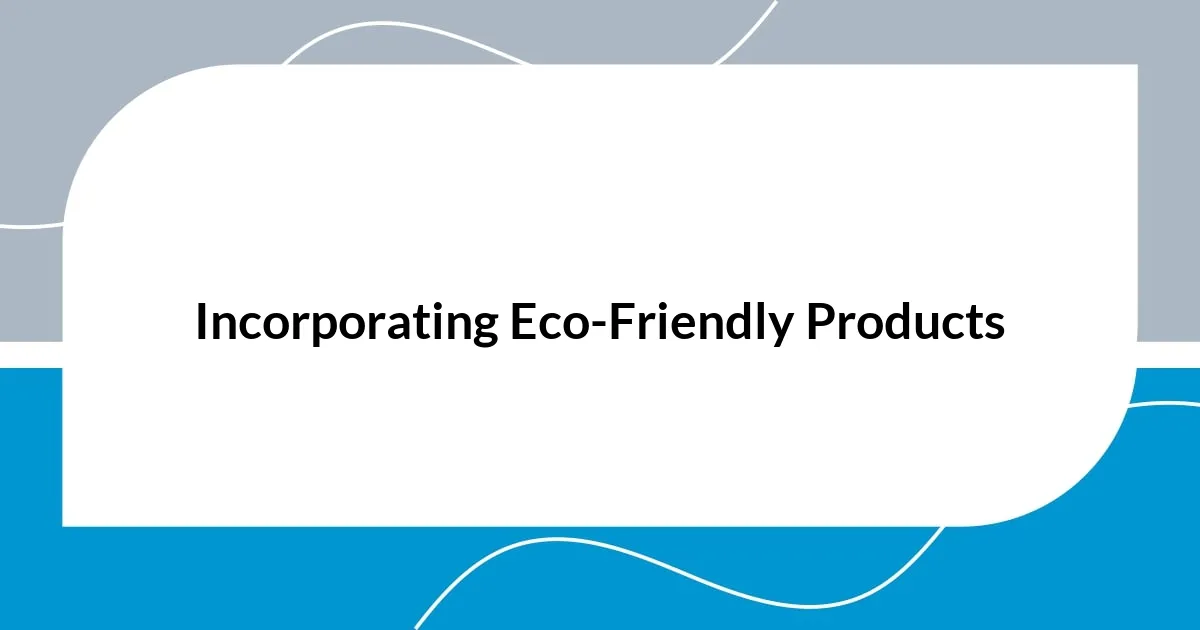Key takeaways:
- Sustainability is about meeting present needs without compromising future generations, prompting reflection on personal choices.
- Assessing daily routines and habits can unveil impactful areas for improvement in reducing one’s carbon footprint.
- Setting achievable sustainable goals fosters a sense of progress and encourages the development of rewarding habits.
- Building a supportive community enhances motivation and collaboration, leading to greater collective environmental impact.

Understanding Sustainability Principles
Sustainability, at its core, revolves around the idea of meeting our needs without compromising the ability of future generations to meet theirs. I remember the moment it hit me – while chatting with a friend who passionately led environmental workshops, she posed a powerful question: “What kind of planet do you want to leave behind?” That question lingered in my mind, pushing me to reflect deeply on my own choices and their impact.
One principle that guides my sustainable lifestyle is the idea of reducing waste. It sounds simple, but I found it surprisingly transformative. After committing to being more intentional with my purchases, I started to see everyday items differently; a glass jar no longer just held jam but could become a storage solution, or even a planter. This shift has sparked joy in creativity, making me feel more connected to my surroundings while minimizing my environmental footprint.
Moreover, embracing a mindset of conservation has been pivotal. It became clear to me that sustainability isn’t just about big gestures; it’s in the small, consistent actions we take daily. I’ve learned to appreciate the art of mindfulness, whether it’s turning off lights when leaving a room or choosing to walk instead of driving. Each decision, no matter how small, has taught me that I have the power to influence change in my life and in the world. Isn’t that the kind of impact we all hope to have?

Assessing Your Current Lifestyle
Assessing your current lifestyle is the first step in making meaningful changes. I remember sitting down one evening with a cup of tea and a notepad, reflecting on my daily routines. I realized that my choices, from the products I bought to how I traveled, had a significant impact on my carbon footprint. Some habits, like opting for takeout in plastic containers, were surprisingly easy to change once I started analyzing them.
To really gauge where I stood, I kept a simple log of my daily activities over a week. I noted everything: my energy consumption, waste generation, and even how often I used my car versus walking. This process wasn’t just enlightening; it was a bit unsettling. Seeing my consumption laid out in black and white forced me to confront areas where I could improve, and I felt a sense of responsibility to do so.
Another aspect I assessed was the cultural influences around me. I found that staying informed often led to better decisions. Engaging in discussions about sustainability with friends not only opened my eyes to new ideas but also inspired me to rethink ingrained habits. It’s fascinating how much our environment can shape our choices, isn’t it? Each realization has been a stepping stone towards a more sustainable lifestyle.
| Aspect | Current Habit |
|---|---|
| Energy Usage | Leaving lights on when not in use |
| Transportation | Driving for short trips |
| Waste Generation | Regularly using single-use plastics |

Identifying Personal Sustainable Goals
Identifying personal sustainable goals is like drawing a roadmap for your journey. Reflecting on what matters most to me made the process much clearer. I recalled a moment during a community clean-up event when I realized how much trash accumulated in our local park. It struck me that my individual actions could lead to a collective impact. This sparked my desire to set goals that would not only benefit me but also contribute positively to our environment.
To help clarify my sustainable ambitions, I started by asking myself a few key questions:
- What is one habit I can change this month?
- Which area of my life generates the most waste?
- How can I make my nutrition more sustainable?
I began with simple, achievable objectives, like reducing my single-use plastic consumption. I felt a rush of satisfaction each time I remembered to bring my reusable bag, reinforcing my commitment to change. The beauty of this is in the progress itself, transforming goals into rewarding habits one step at a time.

Implementing Sustainable Daily Practices
Implementing sustainable practices in my daily life transformed not just my habits, but my mindset. For instance, I decided to shift my shopping routine to prioritize local, seasonal produce. At first, it felt inconvenient, especially when my favorite out-of-season fruits were calling my name. However, that initial discomfort faded when I tasted the difference and felt connected to my community. Isn’t it amazing how something as simple as a grocery shopping habit can ripple out into broader environmental benefits?
I also made a commitment to minimize my water usage at home, which began with the little things. I remember the first time I switched to a low-flow showerhead and consciously kept my showers under five minutes. Initially, it felt rushed, but I found myself appreciating the time saved and the extra moments it created in my day. It’s incredible how re-evaluating something as routine as showering can promote mindfulness. Have you ever considered how small adjustments can result in significant conservation?
Lastly, I embraced the practice of mindfulness when it came to my clothing choices. Instead of mindlessly scrolling through online sales, I started asking myself, “Do I need this?” This introspection led me to adopt a capsule wardrobe, which not only reduced clutter but also helped me appreciate quality over quantity in my purchases. I remember feeling lighter both financially and emotionally, knowing that I was supporting sustainable brands and making conscious choices. Isn’t it liberating to create a wardrobe that aligns with your values?

Incorporating Eco-Friendly Products
Incorporating eco-friendly products into my daily routine has become an exciting journey of discovery. One of the first changes I made was swapping out traditional cleaning supplies for natural alternatives. I’ll never forget the day I made my first all-purpose cleaner using vinegar and essential oils; not only did my home smell delightful, but I also felt a sense of pride knowing I was reducing harmful chemicals skirting around my environment. Have you ever tried making your own cleaning products? It’s surprisingly simple and incredibly satisfying.
As I explored more eco-friendly options, I stumbled upon bamboo toothbrushes and reusable cotton rounds. Initially skeptical, I began phasing out plastic items and was blown away by the quality of these alternatives. The toothbrush, for instance, felt surprisingly good in my hand, and knowing I was doing my part led to a little pep in my step each morning. I now find myself wondering, how many unnecessary plastics can I replace in my life?
I also took a leap into the world of sustainable fashion by choosing brands that prioritize environmental responsibility. During a shopping trip, I came across a beautiful dress made from organic cotton. The moment I slipped it on, I felt a profound connection to the entire process—from the field to my wardrobe. It’s hard to describe, but there’s something deeply rewarding about supporting products that align with my values. Have you experienced that little rush of joy when you choose ethically-made items? It’s those moments that remind me why making sustainable choices is worth every effort.

Tracking Progress and Adjustments
Tracking my progress in adopting a sustainable lifestyle has been an enlightening experience. I started by jotting down my goals and noting down every small change I made, whether it was reducing my plastic use or opting for public transport. This simple act of recording my efforts created a sense of accountability, and I found myself celebrating tiny victories, like remembering to bring my reusable bags while shopping. Have you ever felt that rush of accomplishment for something you initially found challenging?
Adjustments became necessary as I encountered barriers along the way. I remember one week when I attempted a zero-waste grocery run. Despite my best intentions, I found myself overwhelmed by the reality of bulk bins and glass jars. Instead of feeling defeated, I used that feedback to modify my approach. I started smaller, focusing on one item at a time, like switching to bulk grains before tackling produce. It’s interesting how embracing flexibility in this process not only eased my stress but also fostered a deeper understanding of my choices.
Looking back, I often find myself adjusting my tracking system too. I’ve transitioned from mere lists to visual tools like charts and mood boards that make my sustainable journey feel more vivid and engaging. For instance, creating a chart showing my plastic waste reduction not only motivated me but also made it visually satisfying to see my efforts pay off. Have you ever considered how creatively documenting your progress could inspire you even further? By making this journey not just about results but also about the experiences, I’ve come to appreciate every step, no matter how small.

Building a Supportive Community
Building a supportive community around sustainability has been invaluable in my journey. I’ll never forget the first time I joined a local eco-club; it felt like I had found my tribe. Sharing ideas and experiences with like-minded individuals not only fueled my passion but also provided encouragement when I faced challenges. Have you ever experienced that sense of belonging that motivates you to do better? It’s a powerful feeling.
As I engaged more deeply with community events, I discovered the importance of collaboration. Organizing clean-up days or promoting a local farmers’ market brought us together. One memorable afternoon, my friends and I spent hours collecting litter at a nearby beach, which not only beautified our environment but strengthened our bonds. It was inspiring to see how our small actions collectively made a big impact. Could there be a better way to foster a sense of responsibility for the planet than working alongside others?
Support can also come in the form of online communities that share similar values. I found a Facebook group dedicated to sustainable living tips, and it became a treasure trove for insights. When I felt unsure about a new sustainable practice, I’d post a question and get an influx of advice from others who had already navigated the same path. I remember feeling overwhelmed when trying to choose the right composting method, but the suggestions I received not only educated me but also reassured me that I wasn’t alone in my journey. Isn’t it amazing how virtual connections can spark real-life changes?